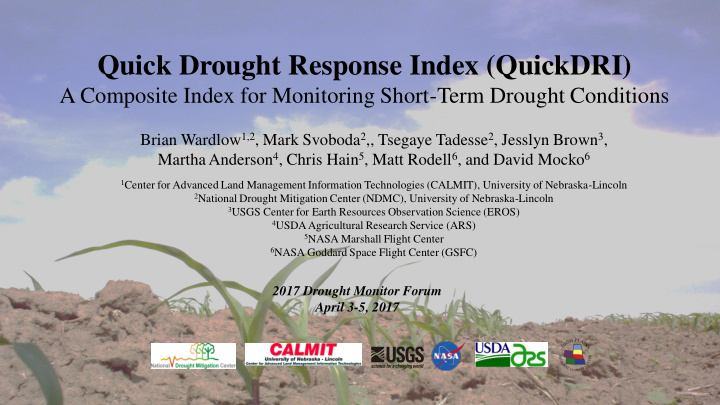



Quick Drought Response Index (QuickDRI) A Composite Index for Monitoring Short-Term Drought Conditions Brian Wardlow 1,2 , Mark Svoboda 2 ,, Tsegaye Tadesse 2 , Jesslyn Brown 3 , Martha Anderson 4 , Chris Hain 5 , Matt Rodell 6 , and David Mocko 6 1 Center for Advanced Land Management Information Technologies (CALMIT), University of Nebraska-Lincoln 2 National Drought Mitigation Center (NDMC), University of Nebraska-Lincoln 3 USGS Center for Earth Resources Observation Science (EROS) 4 USDA Agricultural Research Service (ARS) 5 NASA Marshall Flight Center 6 NASA Goddard Space Flight Center (GSFC) 2017 Drought Monitor Forum April 3-5, 2017
What is QuickDRI? QuickDRI is a shorter-term, composite indicator sensitive to the early stage onset and/or rapidly changing drought conditions (e.g., flash drought) on vegetation. The intent is to serve as an “alarm’ for emerging or rapidly changing drought conditions . Rationale: 1. Early-stage drought conditions and rapidly intensifying drought events are challenging to identify in near real-time. A tool tailored to these characteristics can improve our responsiveness to emerging drought conditions. 2. Over the past decade, a number of satellite remote sensing products characterizing different components of the hydrologic cycle have become available to evaluate drought conditions from different perspectives. 3. Individual drought indicators have their own strengths and weaknesses. A multi- indicator composite index like QuickDRI can collectively leverage strengths of individual indicators while overcoming some of their limitations.
Origins of QuickDRI The Vegetation Drought Response Index (VegDRI) VegDRI is a ‘composite’ drought index that integrates: - satellite-based observations of vegetation conditions (NDVI-based) - climate-based drought index data (36-weekly SPI and self-calibrated PDSI) - biophysical characteristics of the environment (land cover, soils, etc.) to produce 1-km spatial resolution maps that depict ‘drought - related’ vegetation stress. Operational agricultural drought monitoring tool over the CONUS since 2008. Proven to be a useful indicator of ‘seasonal’ drought effects on vegetation conditions, but has limited ability to characterize rapid, short- term changes in conditions.
Emerging Satellite-based Observations and Products Over the past 10+ years, a number of satellite remote sensing-based tools and products characterizing different parts of the hydrologic cycle that influence drought conditions allowing new types of drought indicators to be developed. Remotely sensed or modeled inputs for QuickDRI Examples • Evaporative Stress Index (ESI) • GRACE soil moisture and groundwater anomalies • Vegetation Drought Response Index (VegDRI)
Quick Drought Response Index (QuickDRI) QuickDRI is a ‘composite’ drought index that monitors rapid, short -term changes in drought conditions through the integration of: Other Environmental Evapotranspiration (ET) Precipitation General Vegetation Health Root-zone Soil Moisture Characteristics + + + + • 4-week Standardized • Standardized Vegetation Index (SVI) • 1-month, root-zone soil moisture • 1-month Evaporative Stress Index • Land use/land cover Precipitation Index (SPI) • Irrigation anomaly from VIC (ESI) = • Soil available water holding capacity • Elevation Goal: Use recently available remote sensing products that • Start of season anomaly QuickDRI July 29, 2012 are shorter-term indicators of drought-related environmental conditions to develop a composite drought index that characterizes shorter-term and rapidly developing Conditions Relative to 1-Month Normals drought stress on vegetation conditions on the order of Improvement weeks to a month . Normal Stress Intensification
QuickDRI During 2012 Drought Rapid Onset of Drought Conditions Over U.S. Corn Belt Abnormally dry or moderate drought Strong intensification signal
QuickDRI During 2012 Drought Rapid Onset of Drought Conditions Over U.S. Corn Belt Strong intensification signal Change to more severe drought conditions
QuickDRI Time Series for 2012 Drought
Operational QuickDRI Tool and Products Operational QuickDRI tool and products will be available in late Spring 2017 through a QuickDRI website hosted by the National Drought Mitigation Center (NDMC) at the University of Nebraska-Lincoln and gridded data on the USGS Drought Viewer. • 1-km QuickDRI gridded data for the continental United States • Weekly map updates Beta version of the front page of the QuickDRI website. • 16+ year history of weekly maps dating back to 2001 • Value-added information products available will include: 1. Current and historical maps at national and state levels 2. Annual animations of QuickDRI maps for each year in historical record 3. Suite of other current drought indicator map s (e.g., soil moisture and evapotranspiration) to analyze in combination with the QuickDRI map. 4. Evaluation forms to provide feedbac k on the accuracy and potential applications of the QuickDRI information USGS Drought Viewer ( https://vegdri.cr.usgs.gov/viewer/)
For more information about QuickDRI, please contact: Dr. Brian Wardlow Director and Associate Professor Center for Advanced Land Management Technologies (CALMIT) School of Natural Resources University of Nebraska-Lincoln bwardlow2@unl.edu
Recommend
More recommend